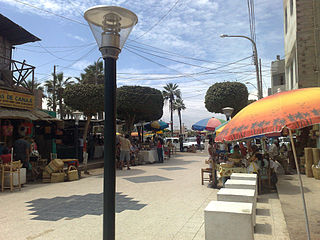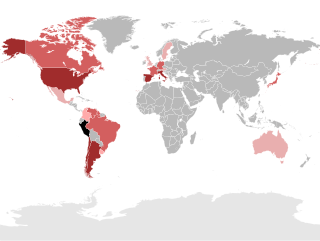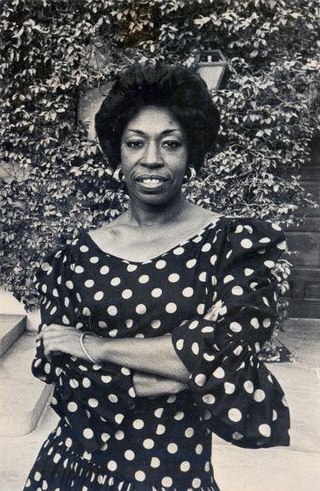The music of Latin America refers to music originating from Latin America, namely the Romance-speaking regions of the Americas south of the United States. Latin American music also incorporate the Indigenous peoples of the Americas. Due to its highly syncretic nature, Latin American music encompasses a wide variety of styles, including influential genres such as cumbia, bachata, bossa nova, merengue, rumba, salsa, samba, son, and tango. During the 20th century, many styles were influenced by the music of the United States giving rise to genres such as Latin pop, rock, jazz, hip hop, and reggaeton.
Peruvian music is an amalgamation of sounds and styles drawing on Peru's Andean, Spanish, and African roots. Andean influences can perhaps be best heard in wind instruments and the shape of the melodies, while the African influences can be heard in the rhythm and percussion instruments, and European influences can be heard in the harmonies and stringed instruments. Pre-Columbian Andean music was played on drums and string instruments, like the European pipe and tabor tradition. Andean tritonic and pentatonic scales were elaborated during the colonial period into hexatonic, and in some cases, diatonic scales.

A cajón is a box-shaped percussion instrument originally from Peru, played by slapping the front or rear faces with the hands, fingers, or sometimes implements such as brushes, mallets, or sticks. Cajones are primarily played in Afro-Peruvian music, but have made their way into flamenco as well. The term cajón is also applied to other box drums used in Latin American music, such as the Cuban cajón de rumba and the Mexican cajón de tapeo.
Afro-Peruvian music, or Música negra, is a type of Latin American music first developed in Peru by enslaved black people from West Africa, where it is known as Festejo. The genre is a mix of West African and Spanish music.

Cañete Province is located in southern Lima Region, Peru. It is bordered by the Lima Province on the north, the Ica Region on the south, the Huarochirí Province and Yauyos Province on the east, and the Pacific Ocean on the west. Its capital is the town of San Vicente de Cañete District. San Luis is the Capital of the Afro-Peruvian Folklore. Is the most populated province in Lima Region and the third most important province in Lima.
Música criolla, creole music or canción criolla is a varied genre of Peruvian music that exhibits influences from European, African and Andean music. The genre's name reflects the coastal culture of Peru, and the local evolution of the term criollo, a word originally denoting high-status people of full Spanish ancestry, into a more socially inclusive element of the nation.
Landó is an Afro-Peruvian form of music in the musica criolla genre.

Susana Esther Baca de la Colina is a prominent Peruvian singer-songwriter, school teacher, folklorist, ethnomusicologist and three-time Latin Grammy Award winner. She has been a key figure in the revival of Afro-Peruvian music.
Perú Negro is an Afro-Peruvian musical ensemble founded in 1969 to celebrate and preserve Peru's black culture and música criolla. Ronaldo Campos de la Colina founded the Lima-based group with 12 family members. The group has been appointed by the government of Peru as the "Cultural Ambassadors of Black Peru." When Ronaldo Campos died in 2001, his son Rony Campos took over the direction of the troupe. Today, the group has over 30 members and a youth troupe, Peru Negrito. The group's album, Sangre de un Don led to the first ever U.S. tour in 2002. In 2005 the group was honored with two Grammy nominations for their second US album, Jolgorio. The first nomination came through the Latin Grammys’ traditional music category and the second for the Grammy's World Music category and in 2008 the group received another Grammy nomination for their album Zamba Malato. In 2010, the group teamed up with famed Peruvian singer, Eva Ayllon to record the album 40 years of Afro Peruvian Classics. The collaboration led to a Latin Grammy Nomination for Best Folk Album.
"Toro Mata" is one of the most famous Afro-Peruvian songs in Peru, which has been recorded and developed by many different musical artists throughout its history. "Toro Mata" is a type of Peruvian music initially developed by enslaved black people in Cañete and Chincha.

Black Peruvians or Afro-Peruvians are Peruvians of mostly or partially African descent. They mostly descend from enslaved Africans brought to Peru after the arrival of the conquistadors.

Dance in Peru is an art form primarily of native origin. There are also dances that are related to agricultural work, hunting and war. In Peru dancing bears an important cultural significance. Some choreographies show certain Christian influence.
Pedro Carlos Soto de la Colina, popularly known as Caitro Soto, was an Afro-Peruvian musician and composer.

Chincha Alta is a Peruvian city located in the Ica Region. A major port at the mouth of the Chincha River, it is the capital of Chincha Province.

Peruvians are the citizens of Peru. What is now Peru has been inhabited for several millennia by cultures such as the Caral before the Spanish conquest in the 16th century. Peruvian population decreased from an estimated 5–9 million in the 1520s to around 600,000 in 1620 mainly because of infectious diseases carried by the Spanish. Spaniards and Africans arrived in large numbers in 1532 under colonial rule, mixing widely with each other and with Native Peruvians. During the Republic, there has been a gradual immigration of European people. Chinese and Japanese arrived in large numbers at the end of the 19th century.
The vals criollo, or Peruvian waltz, is an adaptation of the European waltz brought to the Americas during colonial times by Spain. In the Viceroyalty of Peru, the waltz was gradually adapted to the likings of the Criollo people. In the 20th century, the genre became symbolic of the nation's culture as it gained widespread popularity in the country. It also became popular outside of Peru, particularly in Argentina, where local artists composed many notable Peruvian waltz compositions such as Amarraditos and Que nadie sepa mi sufrir.
San Luis District is one of sixteen districts of the province Cañete in Peru.

Nicomedes Santa Cruz Gamarra was a Peruvian singer, songwriter and musicologist. He was primarily a decimista, a singer of décimas. He researched most forms of Afro-Peruvian music and dance, becoming the leading ethnomusicologist in Peru.

The Son de los Diablos is an Afro-Peruvian dance that developed as a mixture between African, Spanish, and Amerindian rhythms. Nicomedes Santa Cruz explains that, despite popular opinion, the Son de los Diablos has no links with African rituals or with the Andean Morenada, but rather it has a very slight similarity with the Diabladas of Oruro (Bolivia).

Victoria Eugenia Santa Cruz Gamarra was an Afro-Peruvian choreographer, composer and activist.









